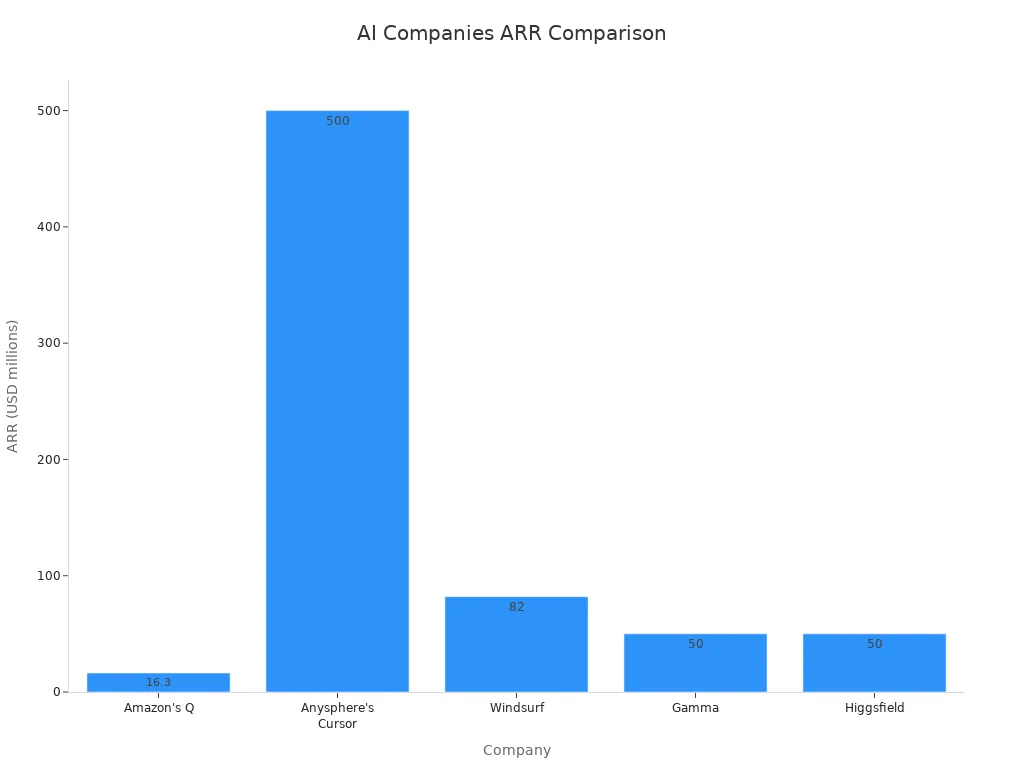The Future of q.ai Company: AI Trends That Might Shape It

You see rapid change in the business world. The Future of q.ai Company depends on how you respond to new AI trends. Experts at PwC and Deloitte highlight these facts:
Your AI strategy leads or lags your competition.
AI agents help your workforce grow.
Responsible AI drives returns.
AI boosts sustainability and shortens product cycles.
AI changes industry competition.
"Top performing companies will move from chasing AI use cases to using AI to fulfill business strategy." – Dan Priest, PwC US Chief AI Officer
Consider how these AI trends could shape your business.
Key Takeaways
Your AI strategy can determine your competitive edge. Align it with your business goals to stay ahead.
Invest in generative AI to enhance product development and improve customer experiences through personalization.
Adopt responsible AI practices to build trust. Focus on fairness, transparency, and data privacy.
Set clear strategic goals for the next five years. This helps you adapt to AI trends and measure progress.
Embrace continuous learning and innovation. This will empower your team and keep your business agile.
Future of q.ai Company

Market Position
You stand in a competitive AI landscape. The Future of q.ai Company depends on how you compare to other leaders. Take a look at the annual recurring revenue (ARR) of top companies in the sector:
Company | Annual Recurring Revenue (ARR) | Notes |
|---|---|---|
Amazon's Q | Modest revenue compared to competitors. | |
Anysphere's Cursor | $500 million | Leading competitor with significant growth. |
Windsurf | $82 million | Strong performance in the market. |
Gamma | $50 million | Rapid growth in less than a year. |
Higgsfield | $50 million | Also achieved significant ARR quickly. |

You see that Anysphere's Cursor leads the market with impressive growth. Windsurf, Gamma, and Higgsfield also show strong performance. Amazon's Q has a modest ARR. The Future of q.ai Company relies on your ability to close the gap and boost your market share.
Strategic Goals
You set clear goals for the next five years. These goals guide your journey and help you adapt to global AI trends. Here is a summary of your strategic priorities:
Strategic Goal | Description |
|---|---|
Strategic Alignment | Aligning AI vision with business goals to ensure coherence and direction. |
Data Strategy | Establishing a governance framework for data management and utilization. |
Talent Development | Focusing on organizational design and talent enhancement for effective AI integration. |
Innovation Approach | Implementing a structured method for innovation and experimentation in AI. |
Continuous Learning | Committing to agility and ongoing learning to adapt to AI advancements. |
You focus on ethical AI governance and transparency. Q-Vision supports automation, which matches the global shift toward agentic AI. By 2028, you expect 15% of daily work decisions to be made autonomously. You also aim to improve software development practices. Only 20% of organizations have made significant progress, so you have a chance to lead.
Tip: Align your strategic goals with global AI adoption trends. This helps you stay competitive and build trust.
The Future of q.ai Company depends on your ability to set clear goals and measure progress. You can shape your market position by focusing on innovation, talent, and responsible AI.
AI Trends

Generative AI
You see generative AI changing how businesses work. Nearly 80% of business and IT leaders believe generative AI will transform industries in the next three years. Investments in this technology have grown fast, from $3 billion in 2022 to over $25 billion in 2023. Experts expect this number to reach $150 billion by 2027. You can use generative AI to help your team learn new skills quickly. AI coaching tools make training faster and more effective.
Generative AI also improves your products and customer experience. These systems adapt in real time to customer behavior, creating personalized interactions. You can keep user data private while reaching more people. Many companies use generative AI to power chatbots, create custom product pages, and predict inventory needs. For example, Amazon Q Business uses AI to recommend products based on real-time data. Media companies use AI to create content faster and at lower costs. The Future of q.ai Company depends on how you use these tools to stay ahead.
AI Agents
AI agents help you automate tasks and make better decisions. These agents learn, adapt, and act on their own. They finish jobs in minutes that would take people hours. Businesses using AI-powered automation can cut costs by 20-40%. You can use AI agents in many areas:
Industry | Applications |
|---|---|
Personalized shopping, inventory optimization, automated customer support | |
Banking & Finance | Fraud detection, automated approvals, compliance monitoring |
Healthcare | Appointment scheduling, patient follow-ups, data analytics |
Manufacturing | Predictive maintenance, supply chain optimization, quality control |
You can use AI agents to automate tasks in healthcare, insurance, energy, finance, transportation, and manufacturing. For example, in healthcare, AI can schedule appointments and help with diagnostics. In finance, AI can detect fraud and support customers. In manufacturing, AI agents can improve production schedules and quality control. By using custom silicon and AI-powered agents, you make your operations faster and more efficient.
Responsible AI
Responsible AI builds trust with your customers and partners. Leading organizations focus on five key principles:
Fairness and bias mitigation
Transparency
Accountability
Privacy and security
Reliability and safety
You must make sure your AI systems treat everyone fairly and explain how they make decisions. You need to protect user data and keep your systems safe. You also need to check for bias and follow new laws about AI. Many companies face challenges with data privacy, algorithmic bias, third-party risks, and legal rules. The Future of q.ai Company relies on your ability to build responsible AI that people trust.
Tip: Regular audits and clear policies help you meet compliance standards and avoid risks.
Industry AI
AI adoption grows fastest in healthcare, finance, IT, manufacturing, and retail. You can tailor AI solutions for each industry:
Industry | Applications |
|---|---|
Healthcare | Diagnostic support, predictive modeling, NLP for medical records |
Finance | Fraud detection, credit risk assessment, chatbots for customer service |
Retail | Dynamic pricing, inventory forecasting, personalized recommendations |
Manufacturing | Predictive maintenance, quality control, demand forecasting |
Logistics | Route optimization, demand trend anticipation, real-time tracking |
Agriculture | Crop health monitoring, yield prediction, automated irrigation |
Education | Adaptive learning platforms, predicting drop-out risks, automating grading systems |
You can use AI to solve problems in each field. For example, in healthcare, AI helps doctors make better decisions. In retail, AI predicts what customers want and manages inventory. In manufacturing, AI keeps machines running smoothly and improves product quality.
Product Development
AI changes how you develop products. Leading companies use AI to improve quality and speed. For example, BMW uses AI computer vision to check car parts for defects. Under Armour uses AI to study customer feedback and improve products. Netflix uses AI to recommend shows based on what you watch.
You can train AI models with your own data to find new ways to work better. Large Language Models (LLMs) help you automate tasks and create content. AI frameworks and orchestration tools help you build and scale your AI projects. AI agents can handle high-volume, time-sensitive tasks, making your workflows smoother. The Future of q.ai Company depends on how you use these tools to create better products faster.
AI Sustainability
AI can help you protect the environment and use resources wisely. New innovations focus on reducing energy use, optimizing logistics, and improving workplace safety.
Innovation Area | Description |
|---|---|
Energy Consumption Reduction | AI analyzes energy use and finds ways to cut waste without hurting productivity |
Logistics Optimization | AI chooses the best delivery routes to save fuel and lower emissions |
Workplace Safety | AI computer vision checks for safety compliance and protects workers |
Biodiversity Monitoring | AI tracks wildlife and habitat health using neural networks and satellite images |
You can measure your AI operations' impact by tracking energy, emissions, and water use. Look at system power, idle energy, and data center overhead. Recent advances have made AI more efficient, cutting energy use and carbon footprints. By focusing on sustainability, you show your commitment to a better future.
Note: Sustainable AI practices help you save money and protect the planet.
Impact on Business
Operations
You can transform your operations by integrating new AI trends. Many companies use AI automation platforms to drive digital change. These platforms combine smart technology with process automation. You should focus on solutions that fit your industry. Connecting AI tools with your current systems helps you work smoothly. Make sure your AI solutions can grow as your business grows. Training your team and managing changes are important for success.
Operational Change | Description |
|---|---|
AI Automation Platforms | Tools that combine AI with process automation for digital transformation. |
Industry-Specific Solutions | Tailored AI solutions for unique industry needs. |
Integration Capabilities | Connect AI with existing systems for seamless operations. |
Scalability | AI solutions that grow with your business. |
Training and Change Management | Processes to train staff and manage changes for successful adoption. |
You can learn from other companies. IBM uses AI for thermal management and predictive maintenance. L’Oreal uses AI to forecast demand and manage inventory. DHL improves delivery with AI-powered logistics. Starbucks personalizes customer experiences with AI recommendations. These examples show how AI boosts efficiency, saves energy, and improves customer satisfaction.
Company | Challenge | Solution | Result |
|---|---|---|---|
IBM | Reduce energy use, improve efficiency | AI for thermal management, predictive maintenance | Lower costs, better reliability |
L’Oreal | Forecast demand, manage inventory | AI algorithms for demand forecasting | Improved inventory, higher satisfaction |
DHL | Optimize delivery routes | AI for predictive logistics | Faster delivery, lower costs |
Starbucks | Personalize experience, manage staff | AI recommendations, workforce scheduling | Better customer experience, more sales |
Competitive Edge
You gain a competitive edge by adopting AI early. Early adoption increases efficiency and productivity. You can foster innovation and stand out in your market. Identifying new technology opportunities helps you improve your processes and meet customer needs. Evaluating the financial impact of AI adoption lets you choose the best solutions. You should analyze costs and benefits, such as lower operational costs and higher efficiency. Embracing AI marks a big shift in how you do business. Companies that adapt quickly will thrive.
Early adoption of AI boosts efficiency and productivity.
Strategic technology use fosters innovation and market leadership.
Identifying new opportunities improves internal processes and meets market needs.
Analyzing financial impact helps select the right solutions.
Embracing AI leads to lasting business success.
You can measure your progress with clear metrics. Track cost per transaction, task automation rate, and time savings per task. Improved sell-through rates and customer lifetime value show how AI helps you grow. Watch your market share and inventory turnover to see how AI helps you respond to trends. Forecast accuracy and data-driven decisions show how AI improves your business.
Metric | Description |
|---|---|
Cost per transaction | Lower costs for order fulfillment with AI. |
Task automation rate | Percentage of tasks handled by AI. |
Time savings per task | Hours saved by using AI for routine work. |
Improved sell through rate | Increased sales from better product placement. |
Increase in customer lifetime value | More repeat purchases and satisfaction. |
Market share growth | Faster response to trends, new segments captured. |
Inventory turnover | Better capital efficiency with smart inventory. |
Forecast accuracy improvement | Fewer stockouts with AI-driven forecasts. |
Data driven decision rate | More decisions based on AI insights. |
The Future of q.ai Company depends on how you use AI to improve operations and gain a competitive edge. You can lead your market by adapting quickly and measuring your success.
Strategies for the Future
Talent and Technology
You build a strong AI team by focusing on people and technology. Personalized outreach helps you connect with top candidates. You can meet future team members at academic conferences and host seminars to show your research culture. Invite PhD candidates to journal clubs for informal talks. Sourcing talent from fields beyond computer science brings new ideas. Peer-to-peer interactions help build trust and ensure a good fit. Offering fellowships supports early-stage researchers and builds long-term relationships.
To keep your team learning, use AI-driven learning systems. These tools give employees control over their learning paths. A growth mindset encourages your team to see challenges as chances to improve. Learning in the flow of work helps skills stick. Blended learning offers choices for different preferences. You see better job performance, career growth, and more innovation.
Tip: Use technology to track progress and align learning with your business goals.
Partnerships
You accelerate AI innovation by building strong partnerships. Collaborate with startups to launch pilot projects and solve real-world problems. Work with companies in robotics and speech translation to explore new solutions. Strategic partnerships, like those between Stellantis and Mistral AI, show how co-developing AI can improve customer experience and efficiency.
Company | Partner | Focus Area | Key Outcomes |
|---|---|---|---|
Yum! Brands | NVIDIA | Restaurant AI | Better customer experience, efficiency |
Stellantis | Mistral AI | Enterprise AI | Improved operations, customer experience |
DXC Technology | Startups | Automotive AI | Solved industry challenges, efficiency |
Use advanced AI tools to gain insights into market trends and client needs. Predictive modeling helps you make smart decisions. AI agents support collaboration and streamline partner identification.
Adaptation
You stay resilient by adapting your business model. Collect and analyze data to guide decisions. Build algorithms to spot patterns and automate tasks. Increase automation so your team can focus on strategy. Encourage innovation by letting teams explore new ideas.
To align with ethical and regulatory standards, define your corporate values and map them to AI objectives. Create an AI ethics charter and build a diverse ethics team. Integrate AI education into your culture and set KPIs to measure progress. Stay transparent with stakeholders and keep up with changing regulations.
The Future of q.ai Company depends on your ability to invest in talent, build strong partnerships, and adapt quickly to change.
You see many AI trends shaping the Future of q.ai Company. Experts highlight new reasoning models, lower inference costs, and the rise of embodied AI. You also face challenges like privacy and digital resource use. To stay ahead, you should:
Invest in AI talent and training.
Address ethical and privacy concerns.
Foster continuous learning.
You build trust and drive growth when you adapt early and use responsible AI.
FAQ
What is generative AI and how can you use it?
Generative AI creates new content, such as text or images, using data and algorithms. You can use it to automate writing, design, and customer support. This technology helps you save time and improve creativity.
How do AI agents improve your business operations?
AI agents handle tasks like scheduling, data analysis, and customer service. You can use them to boost efficiency and reduce errors. These agents learn from data and adapt to your needs.
Why is responsible AI important for your company?
Responsible AI builds trust with customers and partners. You must ensure fairness, transparency, and privacy in your AI systems. Following ethical guidelines helps you avoid risks and meet legal standards.
How can you measure the impact of AI on your business?
You track metrics such as cost savings, task automation rate, and customer satisfaction. Use simple tools to monitor progress. Regular reviews help you see how AI improves your operations.
See Also
The Future of Retail Lies in AI-Driven Stores
Understanding the Growth of AI-Enhanced Corner Shops
Transforming Online Retail Management with AI Tools
Launching a Cost-Effective AI-Driven Corner Store
Vending Machines Evolve: From Snacks to Intelligent Solutions
